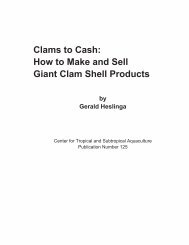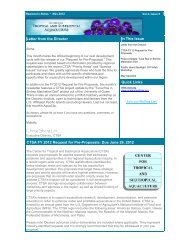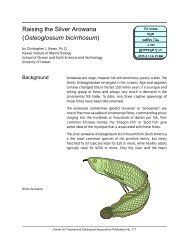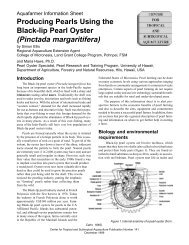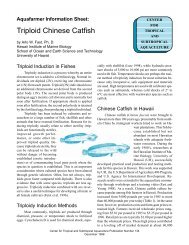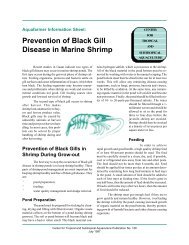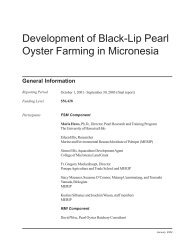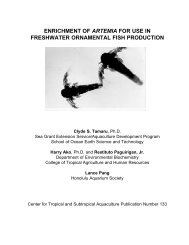The Basic Methods of Pearl Farming: A Layman's Manual - CTSA
The Basic Methods of Pearl Farming: A Layman's Manual - CTSA
The Basic Methods of Pearl Farming: A Layman's Manual - CTSA
Create successful ePaper yourself
Turn your PDF publications into a flip-book with our unique Google optimized e-Paper software.
<strong>Basic</strong> <strong>Methods</strong> <strong>of</strong> <strong>Pearl</strong> <strong>Farming</strong>One problem that may be encountered when using chaplets is that the mon<strong>of</strong>ilament line or stainlesssteel wire used to attach the pearl oysters to the chaplets may break. If this happens, it is usually anindication that heavier line or wire is needed. Also, it may be a sign that the lines are experiencing toomuch motion due to wind or rough water. Sinking the lines a bit deeper or choosing a calmer area forthe farm may help solve this problem.For panels, trays and lantern baskets:When using containers <strong>of</strong> any type, it is important to prevent crowding. Adult oysters should not toucheach other when kept in containers. Try to leave a space <strong>of</strong> at least 4 in (10 cm) around each pearloyster. Fast-growing pearl oysters have shell edges with many small, flattened spines giving it a frillyappearance. If your pearl oysters do not look like this, they are not growing quickly and you should trygiving them more space.If using panels, trays or lantern baskets, clean the pearl oysters first. Soak the new panels, trays orlantern baskets in salt water for 1 week before using, helping to remove any possible contaminationfrom the equipment. Pocket panels are most commonly used for adult pearl oysters and usually hold 6to 18 animals. One difficulty with panels is that they tend to foul rapidly and frequent cleaning isneeded. It is helpful to transfer pearl oysters into new panels at each periodic cleaning, then mend theold panels and let them dry until needed again. Mending and drying <strong>of</strong> the panels can then be doneduring leisure hours and the pearl oysters can be returned to the water immediately. A helpful hintwhen using pocket panels is to insert the pearl oysters into the panels with the byssal notch facingoutwards (towards the frame). <strong>The</strong> pearl oysters will commonly attach themselves to the mesh <strong>of</strong> thepanel and it is easiest to cut them free if the attachment is on the outer edge <strong>of</strong> the panel.With very small pearl oysters (less than 4 in or 10 cm in length), it may be necessary to tie the opening<strong>of</strong> the pockets closed with a piece <strong>of</strong> line to keep them from being dislodged in rough weather.Lantern baskets are best used for spat, since they are too cumbersome to work with when adult pearloysters are kept in them. Lantern baskets must be kept clean and inspected frequently for predators.Trays can be used for either adults or spat, but <strong>of</strong>fer the disadvantage <strong>of</strong> providing little protectionunless covered. As with lantern baskets, they must be cleaned and inspected frequently.Page 32



